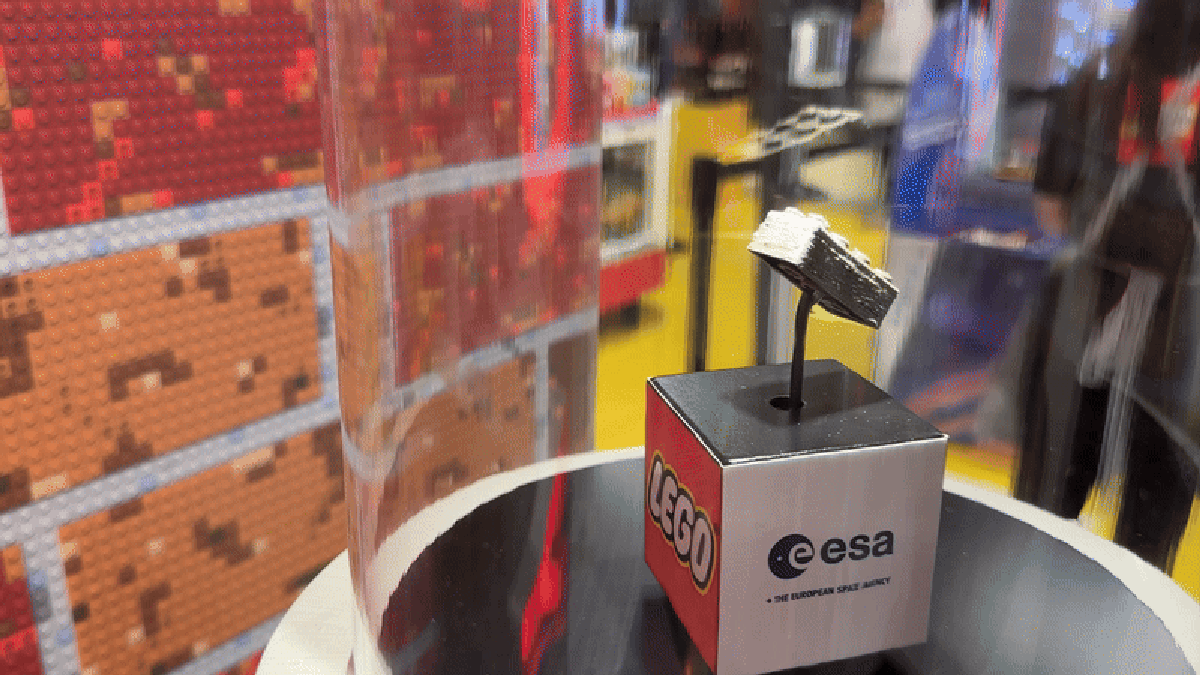In the 5th Avenue Lego store in Manhattan, in the back toward the stairs going to the second level, there’s a small gray brick spinning lethargically on a thin pedestal. According to the Danish brickmaker and European Space Agency, that Lego piece was crafted from meteorite dust. While you won’t see astronauts going into space to try and build the first space edition of Barad-Dûr, the agency claims it’s a small test to see how well Moondust might work for building mankind’s first real lunar structures.
You can’t buy it, and the “Space Bricks” only come in one color—“space gray”—but the stardust building block does look striking up close with its odd wavy lines and dusty appearance you would never see on a modern, pristine Lego piece. According to Lego and the ESA, the meteorite dust was ground off an object first discovered in 2000 in northwestern Africa.
Each brick is not pure meteorite. The 4.5-billion-year-old meteorite dust was mixed with “a small amount” of thermoplastic polyester to let the engineers form it like a Lego piece. It was also mixed with “some regolith simulant,” which in this case is supposed to mimic the kind of dust found on the moon. The actual shape was made with a 3D printer.
So why build a brick out of multi-billion-year-old space dust? According to the ESA, it is to simulate how well this material does when making actual structures. No, future astronauts and space engineers probably won’t start building the first habitable domes on the Moon with Lego bricks, but scientists have tried testing the possibilities of space-based material. There’s, of course, lunarcrete which is a mixture of the Moondust, or regolith, and concrete.
In the release, ESA Science Officer Aidan Cowley is quoted saying that while the brick does look far rougher than your traditional Lego caltrop, “the clutch power still works, enabling us to play and test our designs.” It’s good to know a Space Brick has just as snug a fit as your regular Lego piece.
One of the enduring difficulties of planning for Moon-based structures is bringing what could be many tons of material from the ground into Earth’s orbit. NASA has outlined some prospects for Moon-based maglev transportation systems, though that might require many materials not found on the lunar surface. Recent designs for lunar habitats have ranged from inflatable villages to Moon-based “mobile homes.”
Still, humanity is inching closer to our first real lunar base module. That project founded between NASA, the Italian Space Agency, and the Thales Alenia Space Corporation might not become reality until the 2030s at the earliest, and we’ll have to wait and see what such a project might entail beyond early renderings. A space base is an important step for NASA’s Artemis program and its eventual “Moon to Mars” plan.
Want to see a space Lego in person? You may also be lucky enough to find one at your local Lego store. There are 15 shops in total with a Space Brick, and most are located in major cities in the U.S. We still don’t know if stepping on a Space Brick hurts as much as a regular Lego piece, but we suggest you don’t lose any in the folds of your carpet, just in case.
If you’re really jonesing for some space Legos, you might also want to check out the Lego Artemis Launch System which comes in many more colors than “space gray.”

Daisy Hips is a science communicator who brings the wonders of the natural world to readers. Her articles explore breakthroughs in various scientific disciplines, from space exploration to environmental conservation. Daisy is also an advocate for science education and enjoys stargazing in her spare time.








